Topics
Category
Era
Victory Memorial Drive, Minneapolis
Flag pole on Victory Memorial Drive. The Lake Superior green granite flagpole base was part of the 2009 parkway renovation. The photographer is facing northwest and standing on the sidewalk that connects the flagpole to the Grand Army of the Republic statue of Abraham Lincoln. Photo by Flickr user Paul Rosemeyer, November 11, 2016. CC BY-NC-ND 2.0
Dedicated in 1921, the 3.8-mile Victory Memorial Drive in North Minneapolis is part of the Minneapolis Park System’s Grand Rounds, a fifty-mile circuit of the city’s parks and parkways. It features over 500 memorial trees and markers as well as a central monument and flagpole. This parkway section was named in honor of the Allied victory in Europe and in memory of the 568 Hennepin County residents who died while serving in the armed forces during World War I.
After the creation of the Minneapolis Park Board in 1883, board president Charles M. Loring hired well-known landscape architect Horace W. S. Cleveland. Cleveland called for the construction of a system of large city parks connected by parkways—a recommendation that became a guiding principle for the Park Board.
Plans for Glenwood-Camden Parkway began in 1909 when the Park Board expanded Glenwood Park (now Theodore Wirth Park) at the western edge of the city and purchased land for Camden Park (now Webber Park) in North Minneapolis. Board superintendent Theodore Wirth planned a parkway through the northwest corner of Minneapolis, connecting the two parks. Between 1910 and 1911, the Park Board acquired 170 acres of land. Construction began in 1913.
Crews working south to north built the parkway from Sixteenth Avenue North to Lowry Avenue between 1913 and 1916. In 1917, when the US entered World War I, construction stopped. Construction resumed after the war ended on November 11, 1918, a date known as the Armistice. The parkway to Lowry Avenue was completed and opened for traffic in 1920. This portion of the Glenwood-Camden parkway was named Theodore Wirth Parkway in 1938.
The Armistice also meant that construction north of Lowry Avenue could finally begin. The war, however, had changed the Park Board’s plans. Retired Board president Charles Loring wanted to create a memorial to servicemen and women killed during the war. He donated money for trees to be planted and maintained along the parkway north of Lowry Avenue.
The Park Board planted 568 Moline elm trees as memorials to the 568 Hennepin County servicemen and women who died during the war. Workers arranged them in parallel rows in a wide, grassy median between the north and southbound lanes of the parkway. A wooden cross or Star of David was placed next to each tree. Where the roadway turns to the east at Forty-Fifth Avenue North, the Park Board installed a wooden flagpole. The newly named Victory Memorial Drive was officially dedicated in June of 1921 during a ceremony attended by over 30,000 spectators.
The northwest corner of Minneapolis was mostly farmland in the 1920s, allowing the Park Board to construct a wide, flat, straight roadway. The design created a solemn space for the memorial trees but also catered to the growing popularity of the automobile. Earlier parkways, like those at Minnehaha Falls and around the chain of lakes, were built for horse-drawn carriages. These earlier roads were much narrower and generally conformed to the contours of the landscape.
Shortly after the 1921 dedication, the Park Board began to make updates. In 1923 the wooden flagpole was replaced with a bronze one atop a red granite base. By 1928, Minnesota winters had claimed most of the 568 Moline Elm trees, and they were replaced with hardier elms. At the same time, the wooden crosses and Stars of David were replaced with bronze markers. These were embedded in concrete in 1953.
A new monument was added to Victory Memorial Drive in 1930 when the Grand Army of the Republic dedicated a statue of Abraham Lincoln to their Civil War comrades. The statue, a replica of an Augustus Saint-Gaudens original in Chicago’s Lincoln Park, was installed directly across the parkway from the flagpole.
As the Twin Cities grew rapidly after World War II, increased automobile traffic became a concern of regional planners. In 1959, planners suggested converting Victory Memorial Drive into a county highway. With opposition from the Park Board and the Veterans of Foreign Wars, the plan was scrapped. Victory Memorial Drive could not escape biological threats, however. In the 1970s most of the stately elms along the parkway succumbed to Dutch Elm Disease and were replaced by hackberry trees.
In 2009 Victory Memorial Drive underwent a major renovation when the red granite flagpole base was replaced with a monument of Lake Superior green granite. The Park Board also added flower beds and new trees: a mix of spruce, maples, cedars, birch, and crab apples. The new features were rededicated in 2011. In November of 2018 Victory Memorial Drive was the site of a ceremony marking the 100-year anniversary of the Armistice.
Bibliography
City of Minneapolis Heritage Preservation Commission. “Victory Memorial Drive Historic District.” City of Minneapolis, July 28, 2020.
http://www2.minneapolismn.gov/hpc/landmarks/hpc_landmarks_victory_memorial_drive
Duchschere, Kevin. “Victory Memorial Drive to be Rededicated Saturday.” Minneapolis Star Tribune, June 7, 2011.
http://www.startribune.com/victory-memorial-drive-to-be-rededicated-saturday/123222033
Johnson, Sarah. “Victory Memorial Drive.” Hennepin History 63, no. 1 (Winter 2004): 24–34.
Smith, David C. “Victory Park.” Minneapolis Park and Recreation Board.
https://www.minneapolisparks.org/parks__destinations/parks__lakes/victory_park
Sturdevant, Andy. “Victory Memorial Drive, with its Remarkable Sightlines, Is a Well-named Parkway.” MinnPost, April 3, 2013.
https://www.minnpost.com/stroll/2013/04/victory-memorial-drive-its-remarkable-sightlines-well-named-parkway
Related Resources
Primary
DC. Bell Investment Company. “Victory View on Victory Memorial Drive.” Real Estate
Investment Advertisement, ca. 1927. Available at the Minnesota Historical Society library as F612.H29 R684 1927.
Minneapolis Park Board Annual Reports, 1898–1998. State Archives collection, Minnesota Historical Society, St. Paul.
http://www2.mnhs.org/library/findaids/gr01590.xml
Wirth, Theodore. Minneapolis Park System, 1883–1944: Retrospective Glimpses into the History of the Board of Park Commissioners of Minneapolis, Minnesota, and the City’s Park, Parkway, and Playground System. Minneapolis: Minneapolis Parks Legacy Society,
2006.
Secondary
Smith, David C. City of Parks: The Story of Minneapolis Parks. Minneapolis: Foundation for Minneapolis Parks, 2008.
Soll, David. “Dutch Elm in St. Paul and Minneapolis.” Minnesota History 65, no. 2 (Summer 2016): 44–53.
http://collections.mnhs.org/MNHistoryMagazine/articles/65/v65i02p44-53.pdf
Tishler, William H., and Virginia S. Luckhardt. “H. W. S. Cleveland: Pioneer Landscape Architect to the Upper Midwest.” Minnesota History 49, no. 7 (Fall 1985): 281–291.
http://collections.mnhs.org/MNHistoryMagazine/articles/49/v49i07p281-291.pdf
Twin Cities Public Television. Lost Twin Cities 5, season 2, episode 20. Aired June 1, 2020.
https://www.tpt.org/minnesota-experience/video/lost-twin-cities-5-37523/
Whitman, Albert D. Images of America: Architecture of Minneapolis Parks. Charleston, SC: Arcadia Publishing, 2010.
Web
Hennepin County. “Remembering the Great War: Victory Memorial Drive.”
https://www.hennepin.us/victorymemorialdrive
Hennepin County MN. “Victory Memorial Drive Dedication [2011],” October 27, 2015.
https://www.youtube.com/watch?v=qy_jSXXkz-4
Hennepin County War Records Committee. World War Gold Star Roll of Hennepin County: Program and Exercises for the Dedication of Memorial Trees on the Victory Memorial Highway (Minneapolis: Satterlee Print, 1921). Hennepin County Library, James K. Hosmer Special Collections.
https://reflections.mndigital.org/catalog/mpls:22693
WCCO TV. “Finding Minnesota: Victory Memorial Drive,” November 8, 2015.
https://www.youtube.com/watch?v=51uY0H-AXUQ
Related Images
Flag pole on Victory Memorial Drive. The Lake Superior green granite flagpole base was part of the 2009 parkway renovation. The photographer is facing northwest and standing on the sidewalk that connects the flagpole to the Grand Army of the Republic statue of Abraham Lincoln. Photo by Flickr user Paul Rosemeyer, November 11, 2016. CC BY-NC-ND 2.0
1920 photograph showing the construction of what is now Victory Memorial Parkway, looking south from Thirty Sixth Avenue North. While the image shows a steam shovel being operated in the distance, most of the grading work is being completed using teams of horses and spoil (excess dirt) is being removed by horse and wagon. At the time, the surrounding landscape was undeveloped.
1921 map showing the location of Victory Memorial Parkway relative to the North Loop of Minneapolis. The dashed lines indicate streetcars lines that many of the over 30,000 dedication ceremony attendees could have used to get to what was then the edge of development in Minneapolis. Also shown are the location of the ceremony’s grandstand and speaker’s stand at the northwest corner of the parkway at the site of the memorial flagpole base.
The Abraham Lincoln statue on Victory Memorial Drive was unveiled during a ceremony held on May 25, 1930. The creation and erection of the statue were spearheaded and funded by the Grand Army of the Republic and intended to memorialize Minnesota’s fallen Civil War soldiers. The seated man at center is operating machinery allowing for a radio broadcast of the event.
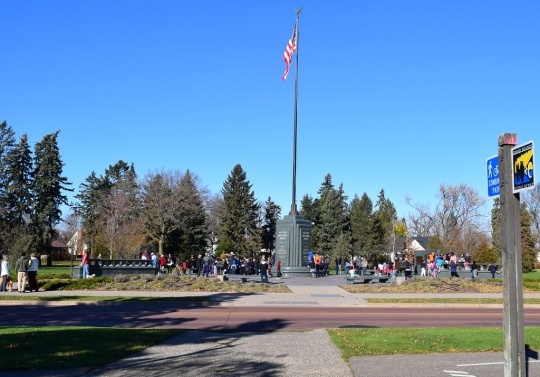
Flag pole on Victory Memorial Drive
Flag pole on Victory Memorial Drive. The Lake Superior green granite flagpole base was part of the 2009 parkway renovation. The photographer is facing northwest and standing on the sidewalk that connects the flagpole to the Grand Army of the Republic statue of Abraham Lincoln. Photo by Flickr user Paul Rosemeyer, November 11, 2016. CC BY-NC-ND 2.0
Holding Location
Articles
More Information
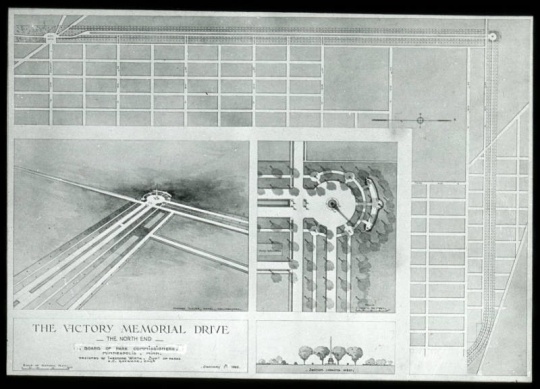
1920 Minneapolis Park Board plans for the north end of Victory Memorial Drive
Cover sheet of 1920 Minneapolis Park Board plans for the north end of Victory Memorial Drive, designed by Theodore Wirth (superintendent of parks) and Alfred C. Godward (engineer).
Holding Location
Articles
More Information
.jpg)
Glenwood-Camden Parkway (now Victory Memorial Parkway), June, 23, 1920
1920 photograph showing the construction of what is now Victory Memorial Parkway, looking south from Thirty Sixth Avenue North. While the image shows a steam shovel being operated in the distance, most of the grading work is being completed using teams of horses and spoil (excess dirt) is being removed by horse and wagon. At the time, the surrounding landscape was undeveloped.
Holding Location
Articles
More Information
.jpg)
Map of Victory Memorial Parkway
1921 map showing the location of Victory Memorial Parkway relative to the North Loop of Minneapolis. The dashed lines indicate streetcars lines that many of the over 30,000 dedication ceremony attendees could have used to get to what was then the edge of development in Minneapolis. Also shown are the location of the ceremony’s grandstand and speaker’s stand at the northwest corner of the parkway at the site of the memorial flagpole base.
Holding Location
Articles
More Information
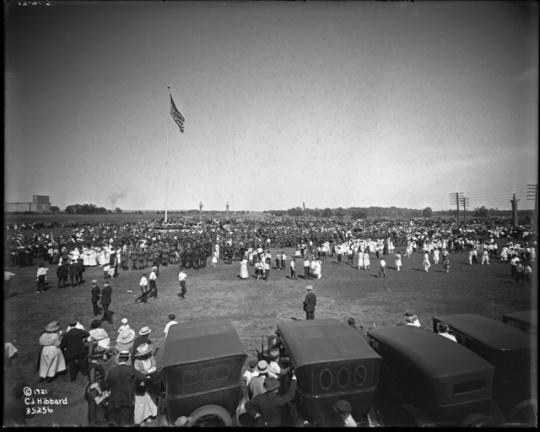
Victory Memorial Drive dedication ceremony
West-facing view of the 1921 dedication ceremony of Victory Memorial Drive in Minneapolis. The memorial flagpole is shown at the center. At the time, the surrounding land was relatively undeveloped.
Holding Location
Articles
More Information
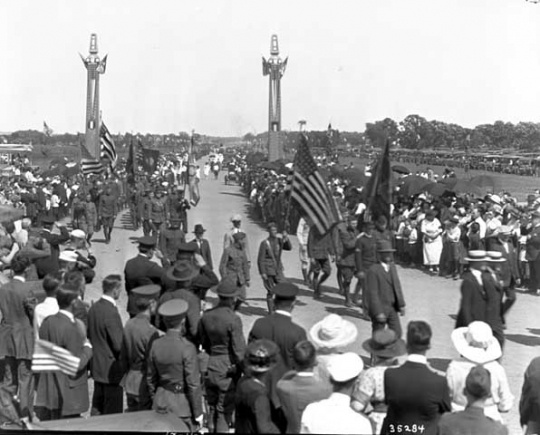
Procession during Victory Memorial Drive dedication ceremony
Image of the 1921 Victory Memorial Drive dedication ceremony showing a procession traveling from west to east. The photographer (C. J. Hibbard) is standing near the memorial flagpole facing west. The decorative pylons appear to have been temporary and built for the dedication ceremony.
Holding Location
Articles
More Information
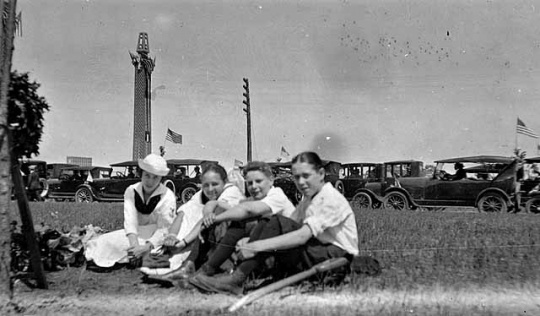
Group next to memorial tree planted on Victory Memorial Drive
Image from the 1921 Victory Memorial Drive dedication ceremony showing a group seated in front of a memorial tree. The trunk of the tree, a wooden cross, and a wreath can be seen at the left of the frame.
Holding Location
Articles
More Information
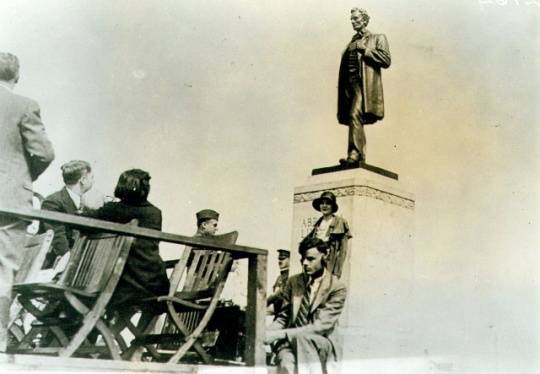
Unveiling the Abraham Lincoln statue at Victory Memorial Drive
The Abraham Lincoln statue on Victory Memorial Drive was unveiled during a ceremony held on May 25, 1930. The creation and erection of the statue were spearheaded and funded by the Grand Army of the Republic and intended to memorialize Minnesota’s fallen Civil War soldiers. The seated man at center is operating machinery allowing for a radio broadcast of the event.
Holding Location
Articles
More Information
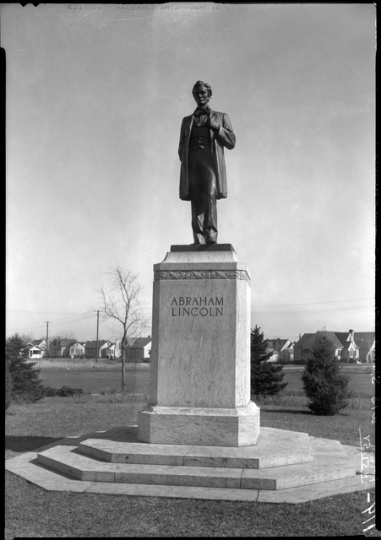
Statue of Abraham Lincoln on Victory Memorial Drive
Statue of Abraham Lincoln erected by the Grand Army of the Republic on Victory Memorial Drive in 1930. Photographed in 1936.
Holding Location
Articles
More Information
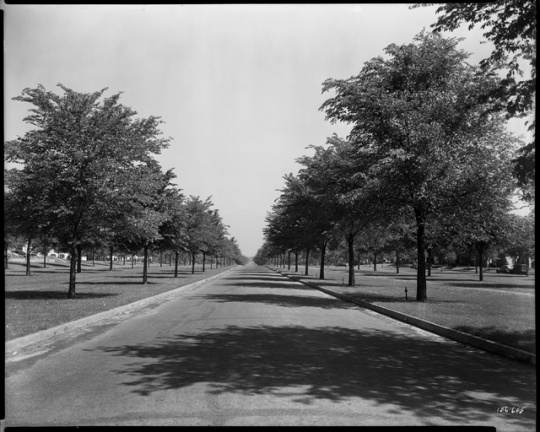
Victory Memorial Drive
Rows of memorial elm trees lining the northbound lane of Victory Memorial Drive, 1945. Bronze crosses are visible in front of the trees on the right side of the roadway. Crosses and Stars of David were embedded in concrete in 1953.
Holding Location
Articles
More Information
.jpg)
Victory Memorial Parkway monument
The base of the flagpole monument on Victory Memorial Drive, ca. 1965. This base and surrounding elements were replaced in 2009 with a similar base and surrounding elements in blue granite.
Holding Location
Articles
More Information
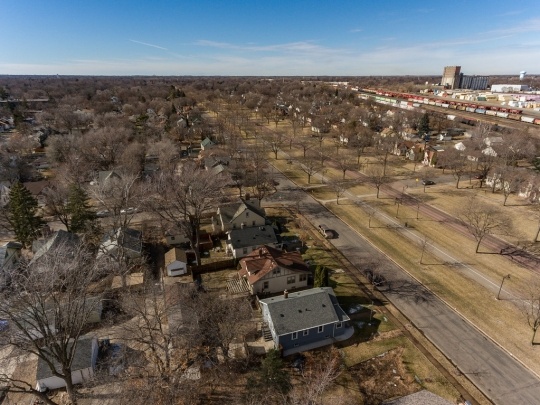
Overhead view of Victory Memorial Drive
Overhead view Victory Memorial Drive and Parkway in North Minneapolis. View looking west from Humboldt Avenue North, near the northeast end of the parkway. Photo by Flickr user Tony Webster, February 18, 2017. CC BY-NC-ND 2.0
Holding Location
Articles
More Information
Related Articles
Turning Point
At the eleventh hour on the eleventh day of the eleventh month of 1918 (11:00 am, November 11, 1918), the combatants of World War I lay down their weapons. This moment marks the end of the war, a date known as the Armistice. With the war over, construction on the parkway in north Minneapolis resumes. The goal of its construction, however, shifts from creating a simply beautiful park and parkland to providing a somber memorial for Hennepin County men and women killed while serving in the war.
Chronology
1883
1910–1911
1913
1918
1920
1921
1923
1925
1928
1930
1959–1960
1970s
2003
2009
2018
Bibliography
City of Minneapolis Heritage Preservation Commission. “Victory Memorial Drive Historic District.” City of Minneapolis, July 28, 2020.
http://www2.minneapolismn.gov/hpc/landmarks/hpc_landmarks_victory_memorial_drive
Duchschere, Kevin. “Victory Memorial Drive to be Rededicated Saturday.” Minneapolis Star Tribune, June 7, 2011.
http://www.startribune.com/victory-memorial-drive-to-be-rededicated-saturday/123222033
Johnson, Sarah. “Victory Memorial Drive.” Hennepin History 63, no. 1 (Winter 2004): 24–34.
Smith, David C. “Victory Park.” Minneapolis Park and Recreation Board.
https://www.minneapolisparks.org/parks__destinations/parks__lakes/victory_park
Sturdevant, Andy. “Victory Memorial Drive, with its Remarkable Sightlines, Is a Well-named Parkway.” MinnPost, April 3, 2013.
https://www.minnpost.com/stroll/2013/04/victory-memorial-drive-its-remarkable-sightlines-well-named-parkway
Related Resources
Primary
DC. Bell Investment Company. “Victory View on Victory Memorial Drive.” Real Estate
Investment Advertisement, ca. 1927. Available at the Minnesota Historical Society library as F612.H29 R684 1927.
Minneapolis Park Board Annual Reports, 1898–1998. State Archives collection, Minnesota Historical Society, St. Paul.
http://www2.mnhs.org/library/findaids/gr01590.xml
Wirth, Theodore. Minneapolis Park System, 1883–1944: Retrospective Glimpses into the History of the Board of Park Commissioners of Minneapolis, Minnesota, and the City’s Park, Parkway, and Playground System. Minneapolis: Minneapolis Parks Legacy Society,
2006.
Secondary
Smith, David C. City of Parks: The Story of Minneapolis Parks. Minneapolis: Foundation for Minneapolis Parks, 2008.
Soll, David. “Dutch Elm in St. Paul and Minneapolis.” Minnesota History 65, no. 2 (Summer 2016): 44–53.
http://collections.mnhs.org/MNHistoryMagazine/articles/65/v65i02p44-53.pdf
Tishler, William H., and Virginia S. Luckhardt. “H. W. S. Cleveland: Pioneer Landscape Architect to the Upper Midwest.” Minnesota History 49, no. 7 (Fall 1985): 281–291.
http://collections.mnhs.org/MNHistoryMagazine/articles/49/v49i07p281-291.pdf
Twin Cities Public Television. Lost Twin Cities 5, season 2, episode 20. Aired June 1, 2020.
https://www.tpt.org/minnesota-experience/video/lost-twin-cities-5-37523/
Whitman, Albert D. Images of America: Architecture of Minneapolis Parks. Charleston, SC: Arcadia Publishing, 2010.
Web
Hennepin County. “Remembering the Great War: Victory Memorial Drive.”
https://www.hennepin.us/victorymemorialdrive
Hennepin County MN. “Victory Memorial Drive Dedication [2011],” October 27, 2015.
https://www.youtube.com/watch?v=qy_jSXXkz-4
Hennepin County War Records Committee. World War Gold Star Roll of Hennepin County: Program and Exercises for the Dedication of Memorial Trees on the Victory Memorial Highway (Minneapolis: Satterlee Print, 1921). Hennepin County Library, James K. Hosmer Special Collections.
https://reflections.mndigital.org/catalog/mpls:22693
WCCO TV. “Finding Minnesota: Victory Memorial Drive,” November 8, 2015.
https://www.youtube.com/watch?v=51uY0H-AXUQ




.jpg?width=200&height=200&name=default%20(1).jpg)
.jpg?width=200&height=200&name=default%20(2).jpg)






.jpg?width=200&height=200&name=default%20(3).jpg)
